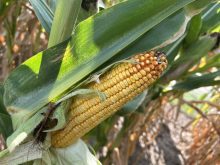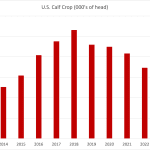Support for corn prices appears strong and that is good news for grain producers of any stripe.
The corn market, because it is a huge crop worldwide and is the biggest U.S. crop, has huge influence on the price of other grains, such as wheat, barley and oats.
Because of the Memorial Day holiday in the United States, the U.S. Department of Agriculture’s crop progress report was delayed and not available as this column was written.
But the previous week’s report showed corn emergence running 33 percent behind the pace in 2007.
Read Also

Pulse fractionation business expected to soon get a boost
Louis Dreyfus Company will soon be producing pea protein isolate at its new plant under construction in Yorkton
Allendale, a large U.S. market analysis firm, said the lag in emergence could reduce yield by 7.3 percent compared to last year.
That would imply a yield of only 140.3 bushels per acre compared to the USDA forecast of 153.9 bu.
USDA’s forecasted harvested area is 78.8 million acres and using its yield forecast, it projects a crop of 12.1 billion bu.
Using Allendale’s yield number you get only 11.1 billion bu., a billion bushels less.
Of course we don’t yet know how many acres will be seeded and harvested, and good summer weather could make up for slow seeding and emergence.
But it is not off to a great beginning.
Chris Hurt, an agricultural economist and grain market analyst at the University of Purdue, noted in his weekly outlook May 13 that total U.S. domestic and export corn demand for the 2007-08 crop year was about 13 billion bu. In the coming crop year, the expanding U.S. ethanol industry will consume an additional one billion bu., implying a potential demand of 14 billion bu. versus 12.1 billion bu. of production, using the USDA forecast.
Even with carry-in of about 1.4 billion bu. that bring total corn available to only 13.5 billion, well short of the potential demand.
High prices will ration demand and Hurt noted that USDA’s forecast reflects this, snipping off a little from several categories. The department figures the U.S. feed industry will use less corn than last year, the export sector will also be less busy and year-end stocks will fall to 763,000 bu. As Hurt noted, that’s a mere 22 days of supply.
Now, imagine where prices would be if production is one billion bu. less than the USDA forecast, as Allendale’s numbers suggest.
In mid May, when Hurt published his article, his assessment was less dire than Allendale’s.
He figured late seeding would drop yields to 151 bu. per acre, and he thought that strong corn prices at seeding were such an incentive that farmers would actually sow 88 million acres, compared to the USDA forecast of 86 million. Hurt’s numbers imply a crop of 12.2 billion bu., slightly larger than the USDA’s forecast.
He also noted that if wheat yields turn out spectacular and wheat prices fall, feeders could switch some demand over to that crop instead of corn. That would act as a lid on corn prices.
On the other hand, soaring oil prices make ethanol producers profitable, increasing the amount they are able to pay for corn.
As always, there are many factors in play. The picture will get a little clearer June 30 when USDA publishes its acreage report.
But it is safe to say the market is on edge about this U.S. corn crop and that builds a strong foundation under its price.














